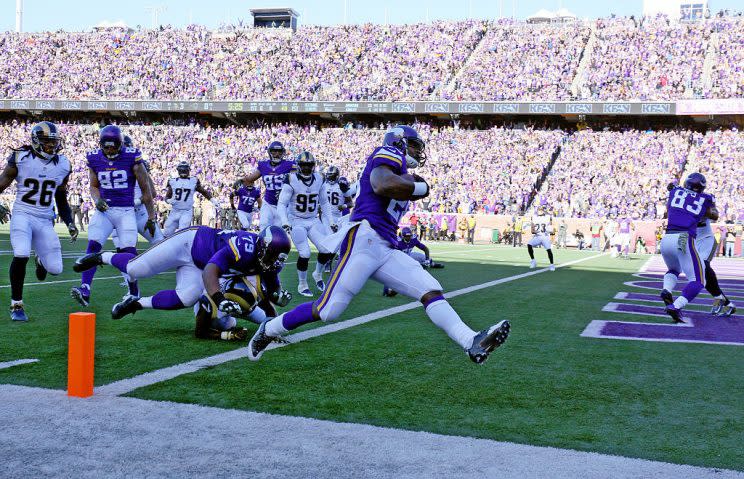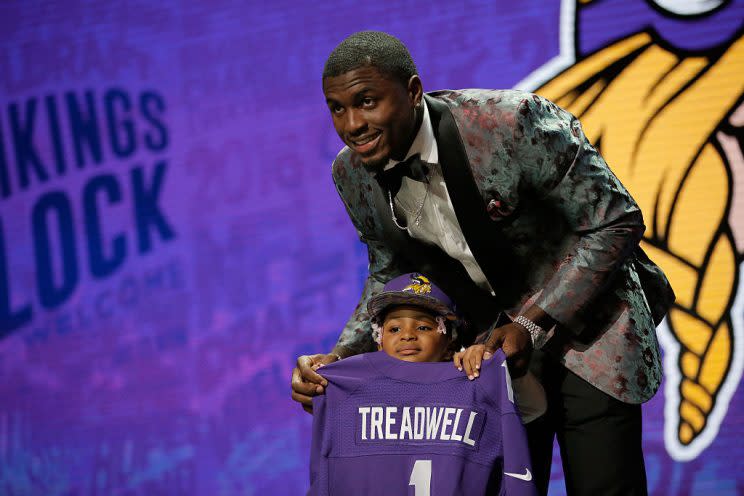Juggernaut Index, No. 22: The Minnesota Vikings

The Juggernaut Index is our annual ranking and review of NFL teams for fantasy purposes — repeat: FANTASY PURPOSES. Here, we concern ourselves with a franchise’s likely contributions to the fantasy player pool. We are not concerned with projected wins and losses. Instead, we’re focused on yards and points. As always, we’re beginning with the league’s least useful teams, working our way toward the elite fantasy juggernauts.
[Yahoo Fantasy Football is open for the 2016 season. Sign up now!]
The same experts who told you to avoid Minnesota running back Adrian Peterson last season (he’s 30!) are, naturally, instructing you to avoid him again this year (he’s 31!) Never mind the fact that Peterson claimed his third career rushing title in 2015, or that he reached double-digit touchdowns for the eighth time, or that he averaged 4.54 yards per carry. Age is a tyrant, they’ll say. Peterson is a high-mileage player who won’t catch more than 40 passes and plays in a middle-tier offense and blah-blah-running-backs-are-fungible-blah.
All I can tell you is that Peterson was a nightmare for opposing defenses last season, just as he’s always been. He appeared in all 16 games for the Vikings, leading the league in both carries and rushing yardage, and he produced five gains of 40-plus yards. His offseason workouts have been ridiculously impressive, too. If Peterson has in fact entered his decline phase, it’s not apparent from any statistical or anecdotal evidence.
While it’s true that many running backs have broken down after turning 30, we’ve also seen a dozen individual 1000-yard rushing campaigns by players 31 and over since the 2000 season. Curtis Martin ran for 1697 yards at age 31. Tiki Barber ran for 1662. Thomas Jones went for 1402. Don’t even try to tell me Peterson can’t deliver 1300-plus yards at an age when Jones was still rolling.
It should go without saying that All Day will eventually slow, that he won’t routinely humiliate and/or overpower would-be tacklers in a few years. But right now, at this moment, he remains one of the NFL’s most dangerous, violent, thrilling ball-carriers. Peterson is still the centerpiece of the Vikings offense, a no-doubt first-rounder in fantasy. Jerick McKinnon is a fun player in his own right, well-priced his ADP (147.4), but he’s simply a rotational back and handcuff entering the year. Assume that his weekly workload will look a lot like it did at the end of 2015, perhaps 7-10 touches per game. If an injury were to sideline Peterson, there’s little question that McKinnon would be a must-start.

Minnesota’s passing game last season was, um … well, it definitely existed, although you might not actually remember it. The Vikes ranked last in the league in pass attempts (454), and next-to-last in completions (294), net passing yardage (2928) and touchdowns (14). It’s unusual in this era for a team to finish a season averaging fewer than 200 passing yards per game, but Teddy Bridgewater and crew managed to do just that. Bridgewater’s stats last year mirrored those from his low-impact rookie season. He risked very little, which led to a low interception total (9) and remarkably few passing scores. Of course it’s not as if he was throwing to Moss, Carter and Reed, so we had no reason to expect huge numbers. Still, his season was a significant fantasy disappointment. You’d like to see growth in some area from year one to year two, and it didn’t happen. Bridgewater’s arm strength isn’t anything special by NFL standards, but he’s accurate enough for a young QB and, again, he doesn’t give away the football. His GM would clearly like to see him give his receivers more big-play opportunities…
“I think just the biggest thing that you want to see is maybe him letting it loose a little more. I don’t want to call him cautious, but he took very good care of the ball because we don’t want to turn the ball over. I don’t want to speak out of turn for the coaches, just letting it loose a little more, giving some guys a chance to make plays even though it may not look like it’s open.”
… so let’s hope it happens.
Bridgewater is a nice enough quarterback in reality, an unfinished product with a winning track record. But for fantasy purposes, he isn’t really in the draft day discussion unless you’re playing in, say, a 16-team league (or some other format in which all starting QBs are likely owned). There’s no reason to expect the Vikings to become less Peterson-centric in the year ahead; Bridgewater is likely to finish with 200 fewer pass attempts than whoever leads the league in 2016. An improved receiving corps will help, as will the team’s return to dome life, but we obviously can’t recommend Bridgewater in any standard fantasy format.
Laquon Treadwell ranked as a top-three receiver on pretty much every scout’s board entering the 2016 draft, but, after landing in Minnesota, he’ll do well to finish his rookie season as a top-40 fantasy wideout. It’s no fun seeing him stuck in a low-volume passing game, even if he’s the presumptive No. 1 target. Treadwell doesn’t have blazing speed (4.6) or uncommon athleticism, but he’s an extremely physical receiver with good size (6-foot-2, 210). He’s also a technician, advanced in his development, a guy who can win 50-50 balls if Bridgewater is ever willing to throw ’em. Treadwell caught 82 passes for 1153 yards and 11 scores against a rough SEC schedule last year, and he capped his season with a three-touchdown performance in the Sugar Bowl. Highlights here. He can play. Minnesota did well to upgrade from Mike Wallace, a limited player who paired so poorly with Teddy. Early drafters are letting Treadwell slide outside the top-100 overall picks (ADP 116.9, WR47), which, to me, seems completely out of sync with his talent. I’ll own him everywhere if this continues.

Stefon Diggs was a revelation as a rookie, leading the Vikings with 52 receptions for 720 yards on 84 targets last season — not bad for a kid who was a healthy inactive throughout September. Diggs broke out in Week 4 in a treacherous matchup at Denver (6-87), then delivered back-to-back 100-yard performances in his next two games. And so ended Charles Johnson’s brief flirtation with fantasy relevance. Diggs and Treadwell each have a realistic shot at seeing 100 to 120 targets in the year ahead, leaving few scraps for supporting players like Johnson, Jarius Wright, Cordarrelle Patterson or tight end Kyle Rudolph. In fantasy leagues of standard size, Diggs and Treadwell are the only Minnesota receivers who belong on your cheat sheet. Rudolph is purely a guy you’ll use to cover a bye week.
The Vikings defense under head coach Mike Zimmer is young, dangerous and creative, a frightening purple horde. Last year, Minnesota’s D ranked fifth in points allowed (18.9 PPG) and seventh in the league in sacks (43). Three members of the Yahoo fantasy squad ranked this defense as a top-10 unit, and everyone ranked ’em as roster-worthy. This team offers multiple IDPs of interest, too, including DE Everson Griffen (10.5 sacks), LBs Anthony Barr and Eric Kendricks, and S Harrison Smith. As long as this crew remains relatively healthy, they have a clear shot to finish the season as an upper-tier fantasy unit.
—
2015 Offensive Stats & Ranks
Points per game – 22.8 (16)
Pass YPG – 183.0 (31)
Rush YPG – 138.2 (4)
Yards per play – 5.2 (25)
Plays per game – 60.5 (31)
—
Previous Juggernaut Index entries: 32) Cleveland, 31) San Francisco, 30) Philadelphia, 29) Baltimore, 28) Tennessee, 27) Los Angeles, 26) Miami, 25) Detroit, 24) Chicago, 23) San Diego, 22) Minnesota

 Yahoo Sports
Yahoo Sports 

